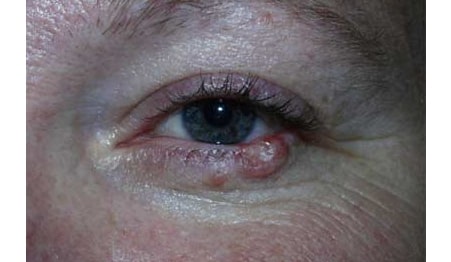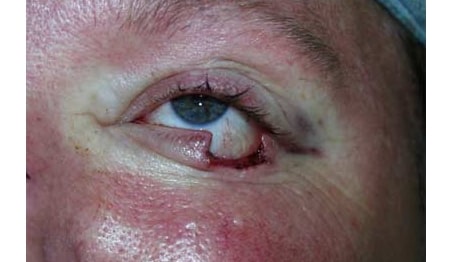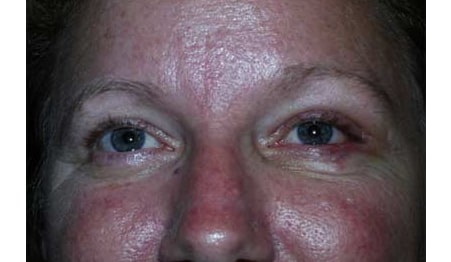Eyelid Lumps, Bumps & Lesions
Eyelid lumps, bumps, and lesions are very common. Most of these tumors and lesions are benign and involve the sweat glands, oil glands, eyelash follicles, and skin elements. They have unusual names, such as hidrocystoma or seborrheic keratosis, but are not dangerous at all. Some eyelid tumors are malignant, the most common being a skin cancer known as basal cell carcinoma.
Dr. Fante is the author of the definitive chapter on eyelid reconstruction in the #1 surgical textbook on the subject: the authoritative Local Flaps in Facial Reconstruction, considered among the essentials in plastic surgery education. Our team is among the world’s most experienced and respected in this field and will use the best possible strategies to restore normal appearance and function when eyelid reconstruction is needed.
Be sure to give Dr. Fante a call today at 303-839-1616 to schedule your eyelid tumor removal consultation in Denver.
Pateint Testimonial
"Dr. Fante is an amazing doctor with tons of experience in eye surgery which is what I was looking for. I couldn’t be happier with the results and he and his staff are incredibly professional and kind!"
Types of Eyelid Cancer
Eyelid cancer is broadly categorized as an epithelial tumor, meaning it is on the outer surface. About 90 percent of all eyelid cancers are basal cell carcinoma skin cancer. When you consider the amount of sun exposure that the eyelids receive, it’s not surprising that skin cancer is prevalent here.
- Basal cell carcinoma— Located under the squamous cells in the lower epidermis are round cells known as basal cells. Around 80 percent of all skin cancers come from this layer in the skin. Basal cell carcinomas most commonly start on the lower eyelid as pearly elevated bumps that bleed easily. It usually grows slowly but can eventually destroy the eyelids and eye.
- Squamous cell carcinoma — This skin cancer forms on the top layer of the epidermis, which consists of mainly squamous cells. It is far less common than basal cell carcinoma, but grows more aggressively and can spread to nearby tissues. It may start in a pre-cancerous form, called actinic keratosis, that appears as a scaly red patch that won’t seem to heal.
- Sebaceous carcinoma — The third most common eyelid cancer, sebaceous carcinoma occurs mostly in middle-aged or older adults. It usually starts in the meibomian glands, that make oil that lubricates the eyes and prevents evaporation of the tears. This aggressive tumor often occurs on the upper eyelid where there are more glands.
- Melanoma – Fortunately this dangerous tumor is very uncommon on the eyelids. It can begin as a brown or pale mass, and if left untreated, it can spread through the bloodstream to other body parts.
Eyelid Lump/bumps & Skin Cancer Treatment Options
At Fante Eye & Face Centre, we use a variety of options to treat eyelid tumors, whether cancerous or benign. We usually start with a biopsy to determine the type of tumor. Based on this information, most benign tumors will require no other treatment, whereas cancers are usually completely removed.
- Biopsy — When a tumor is biopsied to find out if it is cancerous, it can be either incisional (taking part of the tumor) or excisional (taking the entire tumor). If the growth turns out to be benign, an excisional biopsy may be all that’s necessary.
- Mohs or Frozen Section surgery — We use Mohs surgery whenever possible due to the delicate characteristics of the eyelids. When using these techniques, the surgeon or dermatologist will remove the visible eyelid cancer, along with fragments of the healthy skin at the tumor edge. This edge tissue is then immediately examined under a microscope to see if still contains any cancer cells. If cancer cells are still present, they will remove an additional ring of tissue until cancerous cells no longer are present. Once the cancer is gone, reconstruction can be performed to restore the best possible function and appearance.
- Cryosurgery — While this isn’t surgery involving a scalpel, cryosurgery can be an effective method of removing cancers or pre-cancers without removing additional tissue. Cryosurgery uses liquid nitrogen to freeze and kill cancer cells. The frozen cells and skin blister and peel off and reconstruction is usually not necessary. The process is simpler than Mohs or Frozen Section surgery, but the success rate is not as high.
- Radiation and Chemotherapy – Radiation and Chemotherapy are usually not the best single therapy for eyelid cancers, but sometimes are part of the treatment for advanced or complex tumors. We may recommend external beam radiotherapy and drugs such as 5-fluorouracil, aminolevulinic acid, imiquimod, and vismodegib to some patients.
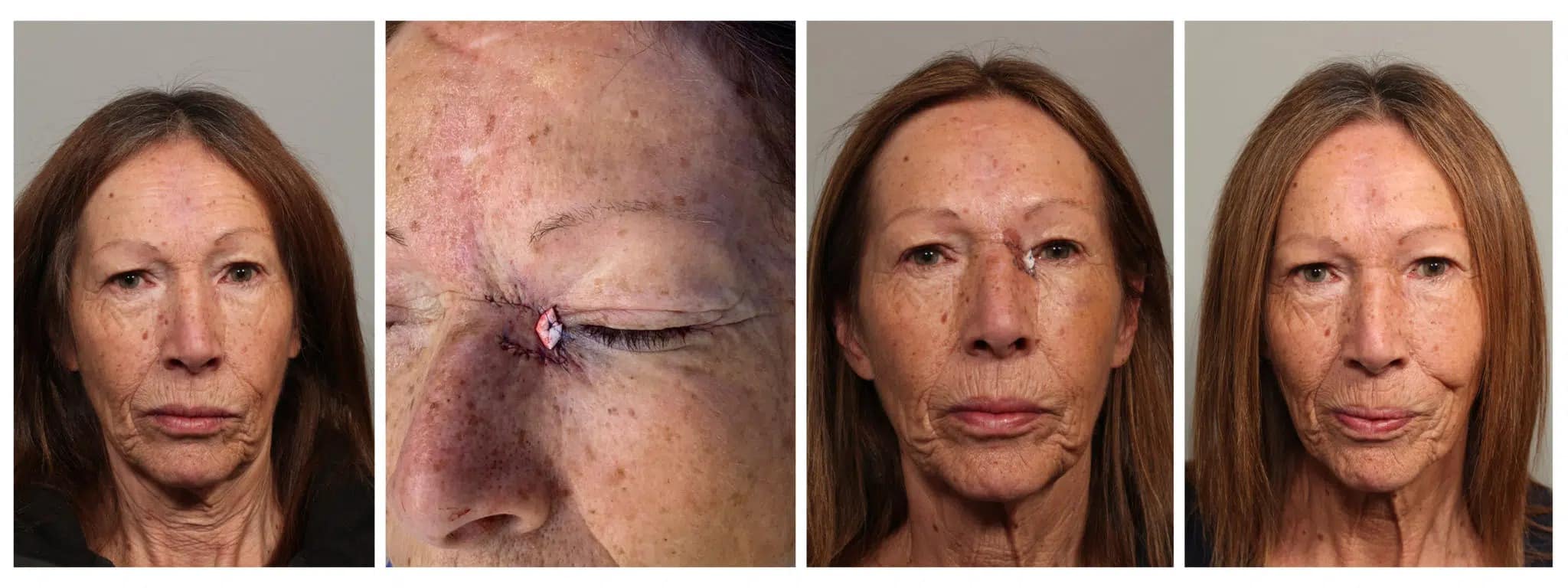
When is Chemotherapy Needed for Eyelid Cancer?
Chemotherapy to treat eyelid cancer is usually prescribed as a topical treatment. It may be used as a nonsurgical treatment for some low-risk basal cell carcinomas, in-situ squamous cell carcinomas, and some sebaceous gland carcinomas of the eyelid.
What Types of Skin Cancer Excision Surgeries Are Available?
In order to cure skin cancer in a particular part of your body, we have to remove every last skin cancer cell. In order to do this, we systematically map the edges (also called margins) of the cancer and excise it in a way that permits microscopic examination of the edges. When all of the edges are free from remaining cancer cells, then reconstruction can begin.
The original method was developed by Dr. Frederic Mohs at the University of Wisconsin in 1938, and it currently performed exclusively by Mohs-certified dermatologists throughout the USA. In Colorado, we work with several exceptionally talented Mohs specialists. The Mohs dermatologist excises the cancer and examines the specimens under the microscope him or herself. Patients are kept comfortable in the Mohs dermatologist’s office and may bring sources of entertainment, such as a book, magazine, or tablet to watch their favorite shows while the doctor is performing tissue examination. If the cancer is small, the Mohs dermatologist will sometimes be able to repair the area. If it is large, the patient will be sent to a surgical specialist for reconstruction the same day or the next day as a second stage. For eyelids, the reconstruction is usually complex and patients are almost always sent to an oculofacial plastic surgeon such as Dr. Fante.
To avoid the two stage process of Mohs surgery, and complex reconstruction another technique was developed called Frozen Section Surgery that permits the skin cancer to be excised and reconstructed at a surgery center or hospital in one stage while the patient receives sedation. The main difference is that the microscopic examination of the skin cancer edges is performed by a board-certified pathologist. For eyelid skin cancers, Dr. Fante will excise the visible cancer, the pathologist will certify that the edges (or margins) are free from tumor, and then Dr. Fante will perform the reconstruction, all while the patient rests comfortably with an anesthesiologist in attendance. For some patients, this is simpler and less stressful. The success rates for both Mohs and Frozen Section Surgery are about the same at over 99% cure.
Who is a Candidate for Skin Cancer Excision Surgery?
Mohs and Frozen Section surgery have become the gold standards for treating basal cell and squamous cell carcinomas on the eyelids and face. Due to the minimized normal skin excision, and careful reconstruction that define these surgeries, they are especially suited to visible skin cancers. The Mohs and Frozen Section surgeries may be appropriate when a growth does not have defined borders, when skin cancer is growing rapidly, and when a patient wants the best possible aesthetic outcome. They are also often performed on recurrent skin cancer growths. If you are wondering if these strategies are right for you, schedule a consultation and examination with Dr. Fante.
Benefits of Mohs Surgery
The team at Fante Eye & Face Centre utilizes Mohs or Frozen Section surgery whenever possible to remove eyelid tumors. This is because this method minimizes the amount of healthy tissue removed in addition to the tumor, and it eliminates the guesswork involved in finding the tumor boundaries.
By continually testing the outer edges of the removed tissue for any remaining cancer cells, there is little to no question when the entire tumor has been removed. That’s why Mohs or Frozen Section surgery has the highest success rate of all surgeries for skin cancer — up to 99 percent. Sometimes the surgery to remove cancer and any necessary reconstruction will be performed by the same surgeon. Sometimes the two stages will be performed by different specialists.
Does Eyelid Cancer Surgery Require Anesthesia?
Eyelid surgery is performed as an outpatient procedure using a local anesthetic only, or a local anesthetic with oral or intravenous sedatives, or a local anesthetic with general anesthesia. A qualified oculofacial plastic and reconstructive surgeon makes this determination based on several factors, including the technique that is being performed, the estimated duration of the procedure, and the problem being addressed. During your consultation for eyelid surgery, Dr. Fante will discuss the particulars of your case.
How Long Does Skin Cancer Excision Surgery Take?
Skin cancer excision surgery is a streamlined process that involves systematic tissue removal followed by immediate microscopic examination. Patients who are scheduled for this procedure are typically advised to clear their calendar on the surgery day. Most of the time, cancer excision surgery is completed in less than 4 hours. However, there is no way to predict this because the process is complete only once the microscopic examination of a layer of tissue reveals no cancer cells.
What Kind of Eyelid Reconstruction Might Be Needed After Eyelid Skin Cancer Excision?
Many cancers are small enough that Dr. Fante can rebuild the eyelid with meticulous placement of stitches that respect the beauty and function of the eye area. However, sometimes larger skin cancers will require more complex reconstruction with the use of local adjacent tissue flaps from the other eyelids, the nose, the cheek, or the temple. Skin and other grafts from elsewhere on the body are also sometimes needed. If the tear drainage system in the inner corner of the eye is damaged by the cancer, it might be necessary to protect or rebuild it so that the eye doesn’t water excessively afterward. Fortunately in all of these cases, patients and their families are usually pleasantly surprised at how normal the eyes look and work once healing is complete. Dr. Fante is world-renowned experts in this field, and have authored the authoritative chapters on Eyelid Reconstruction in the top textbook on the subject, “Local Flaps in Facial Reconstuction” since 2005.
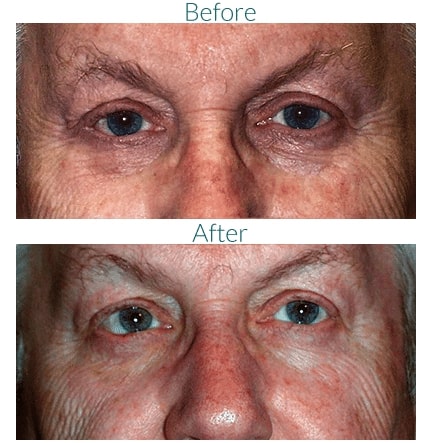
Can My Eyelid Tumor Return After Surgery?
If the tumor is benign and only part of it is removed, then, of course, it can grow back. Depending on the size and appearance, it may or may not make sense to be aggressive about removing a benign tumor since surgery usually creates a small scar.
Similarly, if some cancer cells have been missed by surgery, the tumor can return. As mentioned above, however, Mohs or Frozen Section surgery has an incredibly high success rate for fully removing the tumor.
Of course, removing one skin cancer from the eyelids doesn’t mean that another new tumor can’t eventually develop.
Recovery From Eyelid Reconstruction Surgery
Your recovery will depend on the type of reconstructive surgery used. For instance, a direct closure may be used if the amount of tissue removed is not overly large. Then the skin stitches will be removed after 7-10 days, while deeper ones would absorb over 6-12 weeks. For more involved tumors, skin grafts and the use of skin flaps attached to blood supply might be necessary. Both of these options require more involved in recovery times, and sometimes additional procedures.
Due to the delicate nature of the eye area, bruising and a “black eye” are very common and typically will last 1-2 weeks. Dr. Fante will often prescribe antibiotics eye drops and/or ointments. Temporary eye dryness is common, while pain is uncommon. Mildly blurry vision may occur from ointments but a change in glasses prescription is rare. In the worst cases, it is necessary to temporarily sew the eyelids of one eye closed for a few weeks. Nevertheless, the expertise of Drs. Fante, Hawes, will ensure the best possible outcomes with a return of eyelid function and minimal scarring.
How Long After Eyelid Surgery Can You Drive?
Both anesthesia and pain medications can interfere with coordination and judgment. Patients who undergo eyelid surgery should not drive for at least 24 hours. If prescription pain medication is being taken or vision is blurry, driving should wait until these conditions have passed.
What Are the Risks of Skin Cancer Excision Surgery?
This surgery is generally considered very safe. The few risks associated with this procedure include:
- Anesthesia risks
- Bleeding at the surgery site
- Infection
- Bleeding beneath the skin (hematoma)
- Tenderness or pain at the surgical site
- Visible scars
Though rare, there are also risks of complications such as:
- Temporary or long-lasting numbness at the surgical site
- Nerve or muscle damage
- Eyelid redness, drooping, or other malposition
- Itching or shooting pain
- Dry eyes or watery eyes
- Loss of vision
- Keloid scarring
- Recurrence of cancer
- Need for additional surgery
Call Dr. Fante for Eyelid Tumor Removal in Denver!
To learn more about treatment for an eyelid tumor, contact our Denver office today! Call 303-839-1616 to schedule a consultation with Facial Plastic Surgeon Dr. Robert Fante . You can also click here to send us an Appointment Request Form. Fante Eye and Face Center serve Denver, CO, and surrounding areas.

